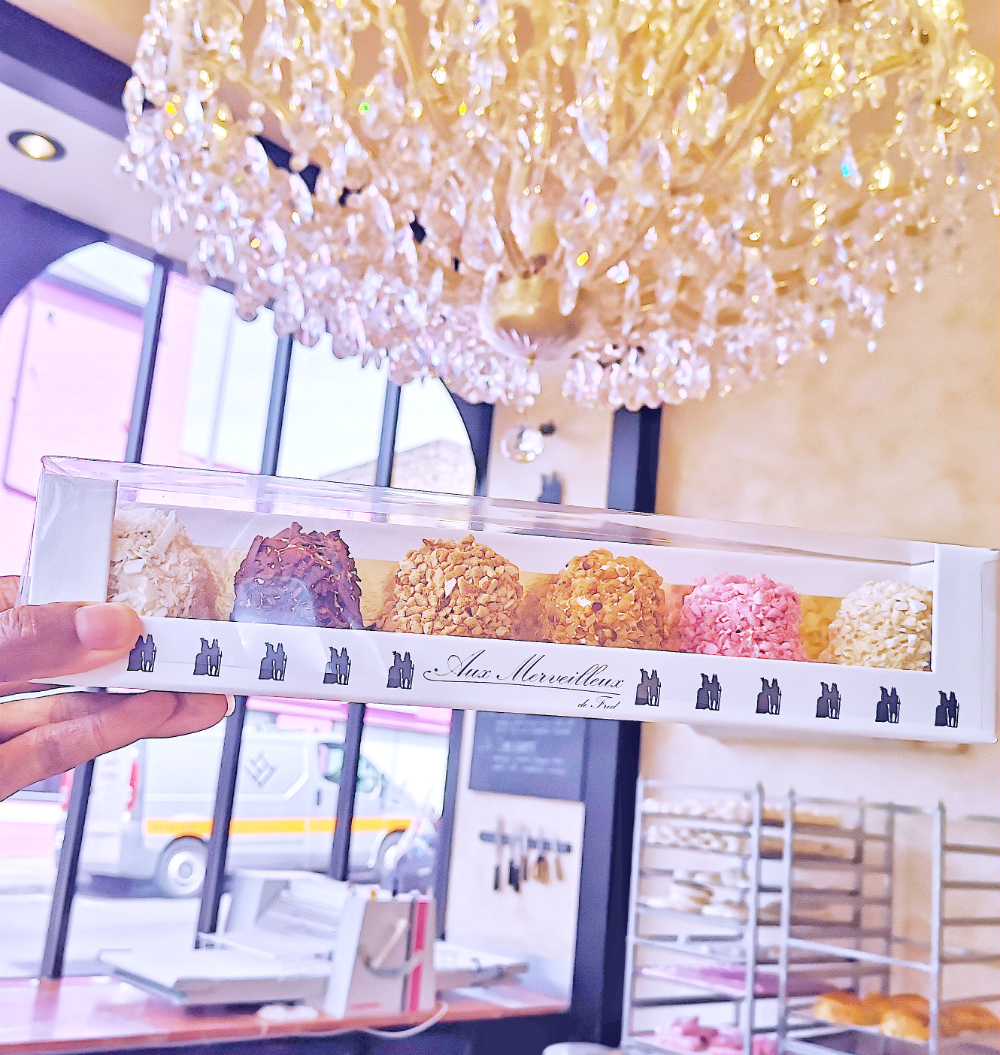Afternoon Tea Etiquette: Master British Traditions Today
Afternoon Tea Etiquette: Master British Traditions Today
Discovering The Rich History Behind Tea Traditions
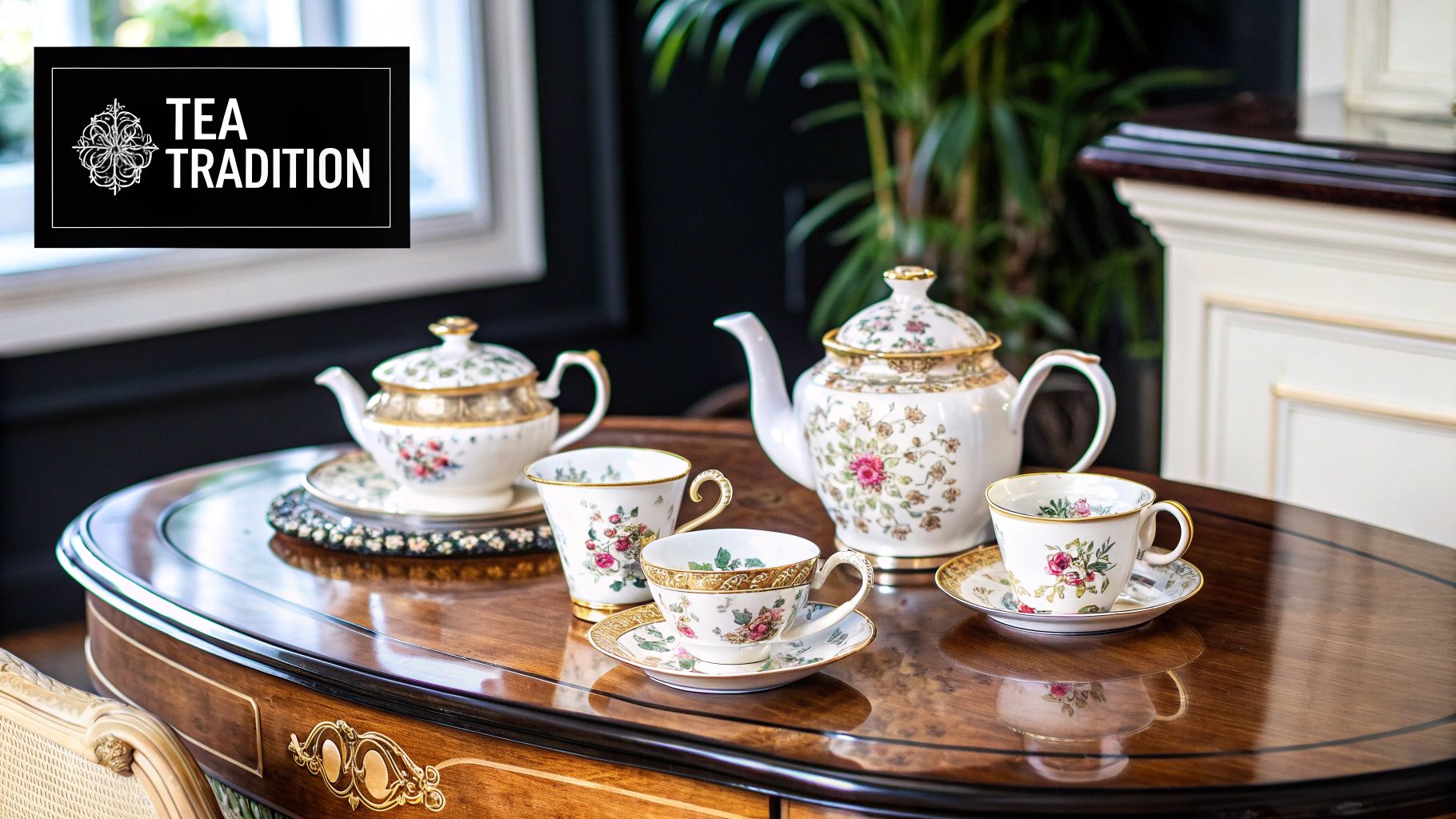
Ever wondered why the British love their afternoon tea so much? It's more than just a cup of tea and a slice of cake; it's a cherished social ritual steeped in history and tradition. This elegant custom evolved from a simple need to a sophisticated ceremony, shaping afternoon tea etiquette as we know it today.
The Duchess and Her Afternoon Hunger
Our story begins in the 1840s with Anna, the seventh Duchess of Bedford. The long gap between lunch and the fashionable late dinners of the time left her feeling peckish. To combat this "sinking feeling," she began requesting a tray of tea, bread and butter, and cake in the late afternoon.
This private indulgence soon blossomed into a social gathering, with the Duchess inviting friends to join her for this refreshing interlude. Afternoon tea etiquette in the UK has deep historical roots dating back to this period.
In fact, by the 1880s, afternoon tea had become a formal social occasion, especially among the upper classes. Women would dress in long gowns, gloves, and hats to attend these sessions, typically held between 4 and 5 pm. Discover more insights about the history of afternoon tea.
From Private Indulgence to Social Phenomenon
This simple act of hospitality resonated with Victorian society. For the upper classes, afternoon tea became an opportunity to showcase their fine china, silver service, and impeccable manners. It provided a structured setting for socializing, networking, and displaying one's refinement. This solidified its position as a key element of British social life.
Royal Approval and the Rise of Tea Rooms
The popularity of afternoon tea reached new heights when Queen Victoria embraced the tradition. Royal endorsement cemented its status as a national pastime. Soon, dedicated tea rooms began appearing across the country.
These establishments offered a more accessible and less formal version of the aristocratic ritual, further democratizing afternoon tea and shaping its future.
The Enduring Legacy of Tradition
Today, afternoon tea continues to be a beloved part of British culture. While the elaborate gowns and formal drawing rooms may be less common, the essence of the tradition remains. Understanding the historical context of afternoon tea deepens our appreciation for its enduring appeal and the significance of proper etiquette.
It's a reminder that every sip and every bite connects us to a rich social history. From a Duchess's hunger pang to a national treasure, afternoon tea has truly stood the test of time. Now, let’s explore the essential manners that make this experience truly special.
Mastering Essential Manners For Confident Tea Service
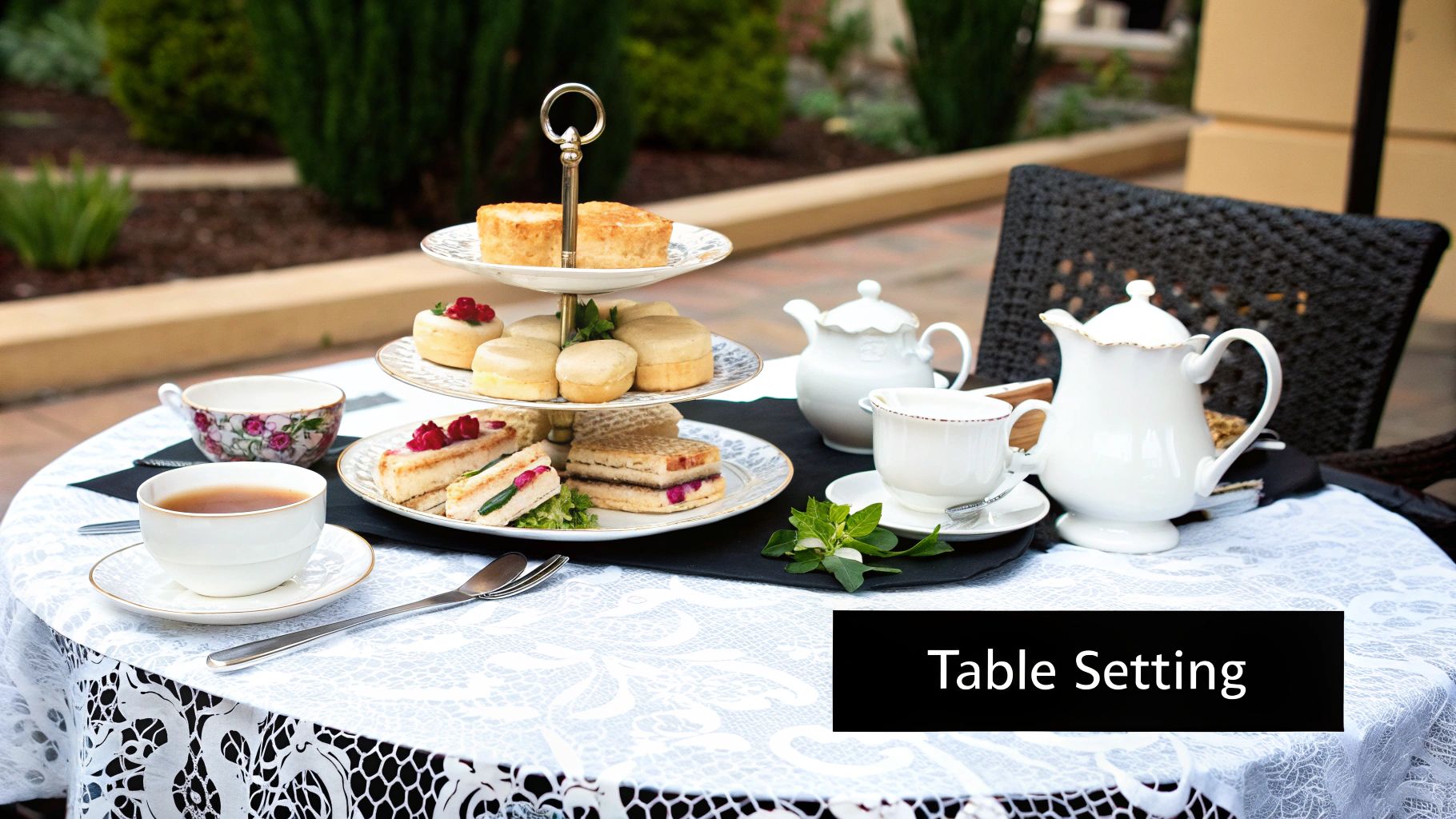
Now that we've explored the fascinating history behind afternoon tea, let's dive into the etiquette that will help you feel comfortable and confident at any tea service. These established customs aren't just about appearing refined; they contribute to a pleasant experience for everyone.
Holding Your Teacup and Stirring with Grace
Let's clear up a common misconception: the pinky-up myth. Extending your pinky finger isn't proper etiquette. Instead, hold the teacup by gently pinching the handle between your thumb and index finger, allowing your middle finger to rest underneath for support. This offers a secure and elegant hold.
When stirring, avoid creating a swirl. A gentle back-and-forth motion, from 12 o'clock to 6 o'clock, is all you need to blend the tea and any additions. Try not to clink the spoon against the cup. And remember, making eye contact with your cup while taking a sip is seen as polite and engaging.
Navigating the Three-Tiered Treat Stand
The three-tiered stand is a signature element of afternoon tea, showcasing a tempting assortment of savories and sweets. There's a specific order to enjoy these treats.
- Start with the bottom tier: savory finger sandwiches.
- Next, move to the middle tier: scones with clotted cream and jam.
- Finally, indulge in the top tier: sweet treats.
Always transfer a portion of each item onto your plate before eating, rather than reaching directly from the stand. This makes for a more graceful and hygienic dining experience.
Pouring Tea and Handling Napkins
When pouring, good hospitality dictates serving your guests first. Hold the teapot handle with your dominant hand, placing your index and middle finger of your other hand on the finial for added stability. Pour your own cup last.
Your napkin should remain unfolded on your lap throughout the service. If you need to excuse yourself, place it neatly on your chair. This indicates your intention to return. You might find this interesting: How to master the nuances of a delightful afternoon tea at Sketch.
The Art of Tea-Time Conversation
Afternoon tea isn't just about the food and drink; conversation is an equally important part of the experience. Keep a pleasant and engaging tone, avoiding loud or disruptive discussions. Show genuine interest in your fellow guests and contribute thoughtfully to the conversation, fostering a relaxed and enjoyable atmosphere for everyone.
Handling Mishaps with Grace
Accidents happen. If a spill or mishap occurs, there's no need to panic. Simply apologize if necessary and discreetly inform a staff member, who will be happy to assist. Avoid making a fuss or drawing unnecessary attention to the incident. A calm and composed demeanor is always best.
To further illustrate proper tea etiquette, let's take a look at the following table:
Afternoon Tea Etiquette Do's and Don'ts
This table provides a comprehensive comparison of correct and incorrect behaviors during afternoon tea service. Understanding these guidelines will enhance your overall experience and demonstrate respect for this time-honored tradition.
By understanding these do's and don'ts, you can navigate any tea service with poise. These essential manners, combined with an appreciation for the history of afternoon tea, will ensure a delightful and memorable experience.
Perfecting The Art of Hosting and Tea Presentation
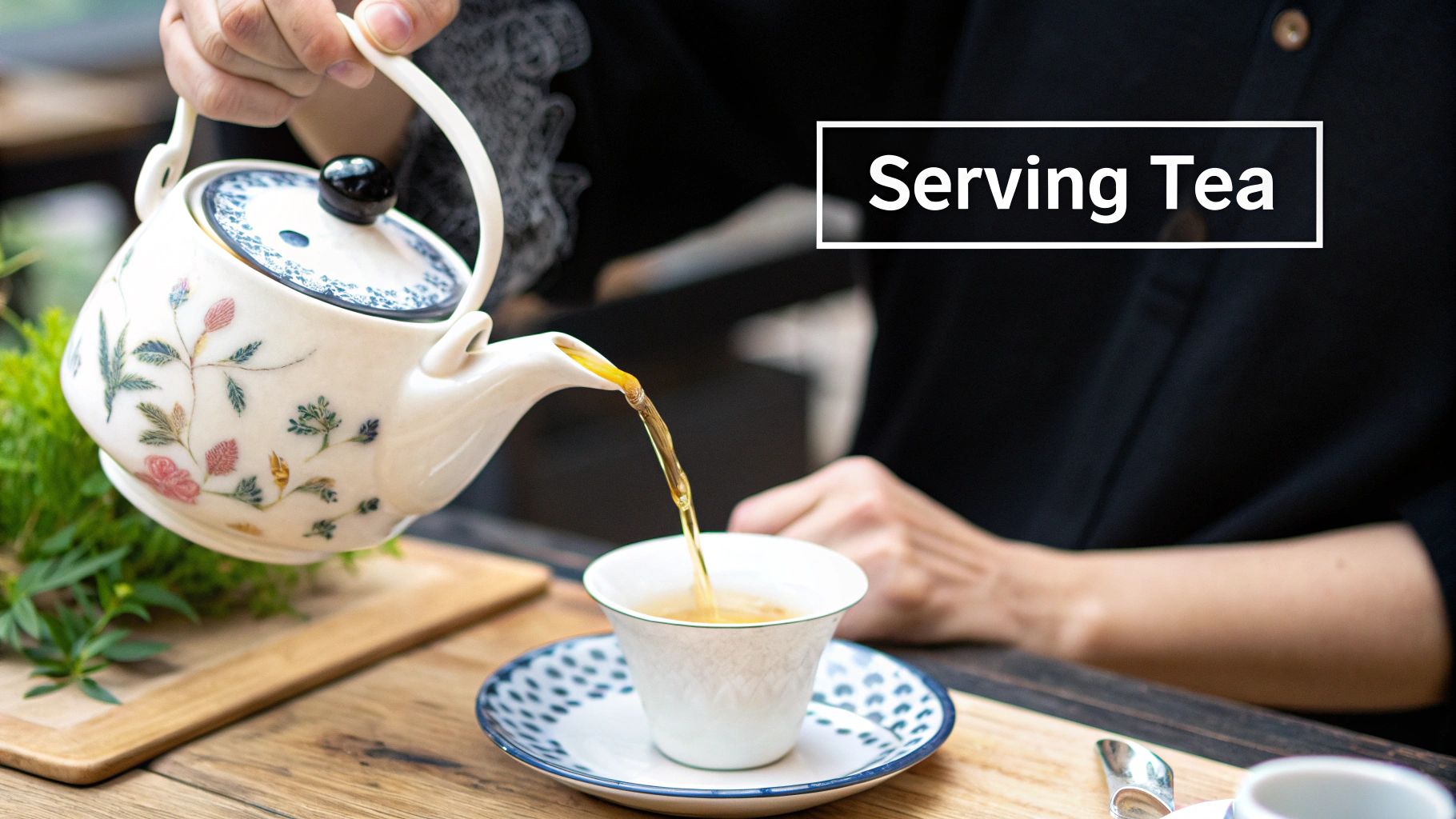
Transforming afternoon tea into a truly memorable event goes beyond simply brewing a delicious cup. It's about crafting an experience that engages all the senses, focusing on the art of presentation and hosting. This means understanding the subtle details of tea service, from pouring techniques to the elegant display of treats.
The Hostess's Role: A Graceful Orchestration
As the hostess, you orchestrate this delightful occasion. Your role begins with selecting the teas, offering a variety to complement your guests' tastes. This might include traditional black teas, invigorating herbal infusions, or perhaps a light fruit tea.
The presentation of the tea service itself is paramount. Bone china, known for its translucence and delicate elegance, adds a refined touch. While not mandatory, silver service enhances the experience further, reflecting the light and creating a sense of occasion.
Formal tea service training stresses the significance of these details. Interestingly, studies indicate that hosts adhering to traditional pouring methods and presentation standards cultivate notably more positive guest experiences, with 73% greater satisfaction. Proper timing and temperature control are identified as key factors. Find more detailed statistics here.
Timing and Temperature: The Secrets to a Perfect Brew
Timing is critical for afternoon tea. The tea should be freshly brewed and served hot, but never scalding. This requires careful consideration of water temperature and brewing duration to ensure the delicate flavors are properly extracted.
For instance, black teas typically require boiling water and a brewing time of 3-5 minutes, while herbal infusions often benefit from slightly cooler water and a longer steeping time. Mastering these subtleties guarantees a perfect cup every time. How to master unique and quirky tea experiences offers additional insights.
The Art of Pouring and Serving
Pouring the tea itself is a graceful gesture. As the hostess, pour for your guests first, showcasing care and attention. Hold the teapot handle securely, using your other hand to support the finial.
After pouring, offer milk, sugar, and lemon, allowing guests to personalize their tea. Presentation extends to these accompaniments as well. A well-arranged sugar bowl, a small milk jug, and a dish of lemon slices add a touch of refinement.
Presenting the Treats: A Feast for the Eyes
The arrangement of the three-tiered stand is another crucial element. Begin with savory finger sandwiches on the bottom, followed by scones with clotted cream and jam in the middle. Finally, arrange the sweet treats on the top tier, creating a visually appealing presentation.
Encourage guests to help themselves, offering plates and assistance. This smooth flow of service contributes to a relaxed and enjoyable atmosphere, ensuring your afternoon tea is a resounding success. By attending to these details, you create a memorable experience your guests will treasure.
Understanding Afternoon Tea Versus High Tea Differences
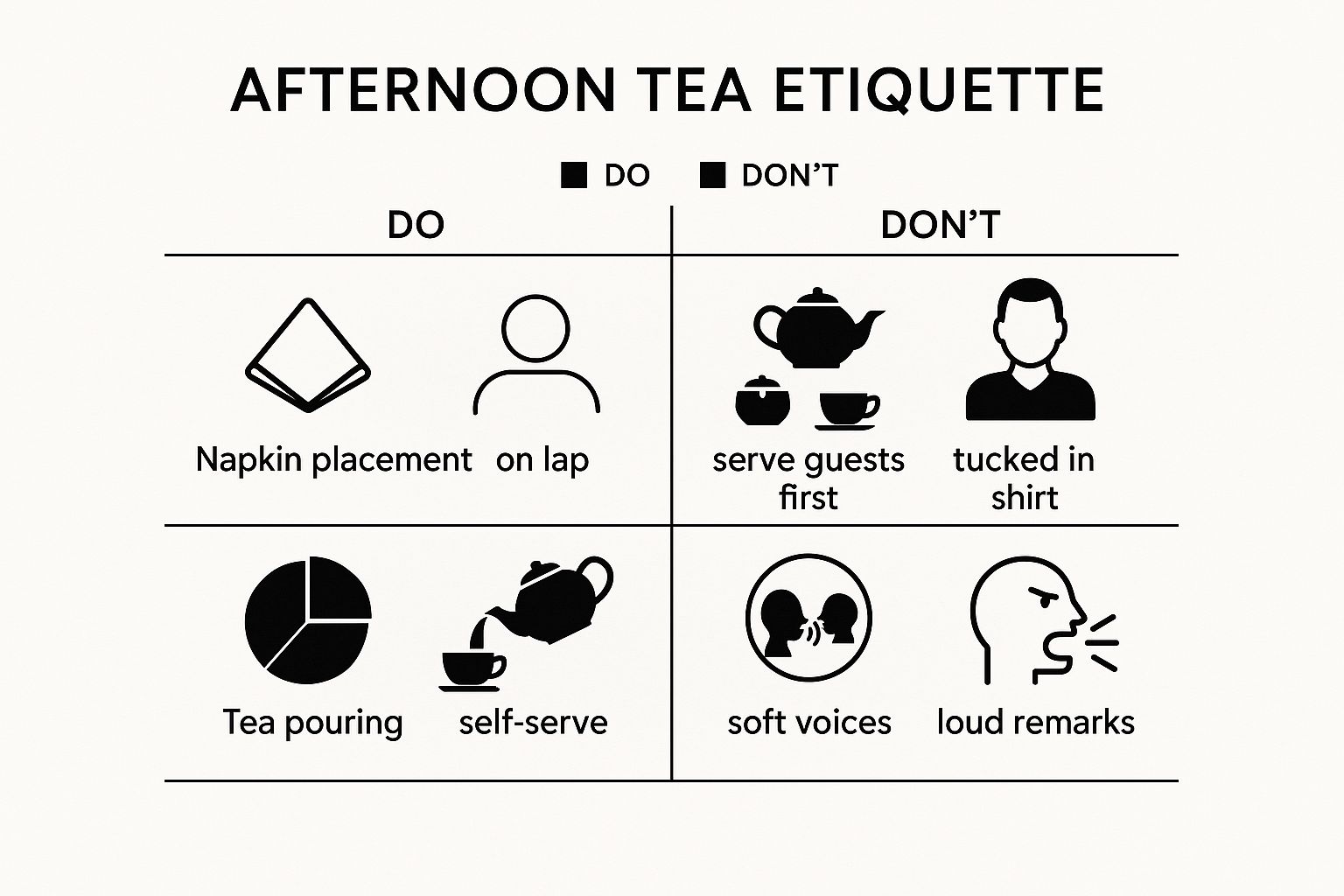
This infographic offers a handy guide to afternoon tea etiquette. It covers everything from napkin placement to the order of tea pouring and appropriate conversation levels. As shown, a soft voice, serving guests first, and keeping your napkin on your lap all contribute to an elegant tea experience. These small details truly enhance the atmosphere. The difference between afternoon tea and high tea is often confused, so let's clear things up.
Delicate Bites Versus Hearty Meals
Afternoon tea, typically served between 4 and 5 pm, is a light social gathering. Think delicate finger sandwiches, scones with clotted cream and jam, and charming pastries. It's a chance to pause, relax, and connect with friends. Looking for the best spots in London? Our guide to the best afternoon tea experiences the city has to offer is a great place to start.
High tea, on the other hand, is a much more substantial meal. It has its roots in the working class tradition of enjoying a filling meal after a long day, usually served between 5 and 7 pm. High tea features heartier dishes, including meat, vegetables, bread, and, naturally, tea.
Social Occasions and Settings
Over time, the differences between these two tea traditions became even more distinct, reflecting social customs in the UK. Afternoon tea developed into a refined social ritual, while high tea remained a practical meal for working-class families. Afternoon tea was a light social event served mid-afternoon. High tea, with its working-class origins, was a more substantial early evening meal featuring tea, meat, vegetables, and bread, served between 5 and 6 pm. This divergence highlights the social nuances of tea drinking and its etiquette across different social groups in the UK. Learn more about the history and etiquette of afternoon tea.
Understanding the Context: Why It Matters
Knowing the difference between afternoon tea and high tea helps you avoid social missteps. It demonstrates respect for British customs and cultural awareness. This knowledge is particularly helpful when making reservations or planning events. Understanding whether to expect dainty sandwiches or a larger meal ensures everyone is on the same page. It also showcases your knowledge of the history and social significance behind these cherished British traditions.
To illustrate the key distinctions, let's look at the following comparison:
Afternoon Tea vs High Tea: Key Differences
This table highlights the core differences between afternoon tea and high tea, from the time of day they are served to the types of food you can expect. The social and historical contexts are also essential to understanding the evolution of these traditions.
Choosing the Perfect Attire for Every Tea Occasion
Dressing for afternoon tea is a delightful ritual, a chance to blend tradition with your personal style. Whether it's a relaxed gathering in a tea garden or a formal celebration at a prestigious hotel, understanding the dress code elevates the whole experience.
Decoding the Dress Code: From Casual to Chic
Different venues call for different levels of formality. A casual tea garden setting allows for a more relaxed approach. Think stylish separates, a flowy dress, or even smart jeans with a polished top. Comfort is essential, but maintaining a sense of occasion is still important.
Formal venues, such as upscale hotels or celebratory events, require a more sophisticated look. A classic dress, a tailored suit, or a skirt and blouse combination are all excellent choices. Adding elegant accessories, like a statement necklace or a stylish hat, completes the ensemble.
Smart Casual: The Goldilocks of Afternoon Tea Attire
For many afternoon tea experiences, smart casual is the perfect dress code. It's the ideal balance between relaxed and refined, allowing for self-expression while maintaining a polished appearance.
Think of smart casual as elevated everyday wear. Well-fitting trousers with a stylish blouse, a knee-length dress, or a smart skirt and top combination all fit the bill. A blazer or cardigan adds an extra layer of sophistication.
Seasonal Considerations: Dressing for the Occasion and the Weather
The season also influences attire choices. In warmer months, lighter fabrics and brighter colors are appropriate. Flowy dresses, linen trousers, and pastel hues create a fresh, summery vibe.
During colder months, opt for warmer fabrics like wool or cashmere. A tailored coat, stylish boots, and richer colors add a touch of seasonal elegance. Dressing for the weather ensures you stay comfortable and stylish.
Accessorizing With Flair: The Finishing Touches
Accessories can elevate any afternoon tea outfit. A statement necklace, a delicate scarf, or a stylish hat adds personality and flair. Remember to keep accessories balanced and appropriate for the venue.
For formal occasions, consider a fascinator or a wide-brimmed hat. For more casual settings, a simple scarf or a statement necklace can be equally effective. Choosing accessories that complement your outfit and the occasion adds a polished finish.
Respecting Tradition While Expressing Your Style
The ultimate goal is to feel confident and comfortable while honoring the tradition of afternoon tea. While guidelines exist, there's always room for personal expression. Choose attire that reflects your style and makes you feel your best.
By understanding dress codes and adapting them to your preferences, you can fully enjoy the afternoon tea experience. This ensures you're dressed appropriately while showcasing your unique style. Feeling good in what you wear boosts your confidence and allows you to embrace the charm of this beloved tradition.
Navigating Today's Diverse Afternoon Tea Experiences
Afternoon tea in the UK is no longer just cucumber sandwiches and tiered stands in grand hotels. It's blossomed into a diverse experience, offering a range of options from quaint village tea rooms to themed afternoon teas celebrating everything from literature to pop culture. This variety is exciting, but understanding modern afternoon tea etiquette helps you choose the perfect experience and enjoy it to the fullest.
Choosing the Right Venue: From Traditional to Trendy
Finding the right venue depends on the occasion and your preferences. Traditional hotels offer a classic, elegant setting ideal for celebrations or impressing guests. These venues often adhere to stricter etiquette, creating a more formal atmosphere. For a more relaxed experience, consider a charming tea room or a modern café. Themed afternoon teas are also growing in popularity, putting a unique spin on the classic tradition. These might revolve around popular books, films, or historical periods, creating a fun and engaging experience.
Understanding Pricing Structures and Making Special Requests
Afternoon tea prices can vary significantly based on the venue, menu, and added extras. Some offer set menus, while others let you choose from various options. It's always wise to check pricing beforehand. Many venues accommodate dietary needs or special requests. Communicating these politely and in advance is key. For example, if you have a gluten intolerance, letting the venue know when booking allows them to prepare alternatives.
Booking Etiquette and Ensuring a Smooth Experience
Booking methods have evolved alongside the venues themselves. While calling is perfectly acceptable, many now have online booking systems, sometimes with options to specify dietary needs and preferences. When booking, confirm the number of guests, the date and time, and any special needs. This helps the venue prepare and ensures a smooth experience.
Also, be mindful of arrival times. Arriving a few minutes early is recommended, giving you time to settle in. If you're running late, a quick call to the venue is appreciated.
Tipping Guidelines and Showing Appreciation
Tipping is customary in the UK for afternoon tea. A 10-15% tip is generally appropriate for good service. Some venues include a service charge, so check the bill before adding a tip. Expressing your appreciation verbally or through a note is a thoughtful gesture.
Making Everyone Feel Comfortable and Included
Afternoon tea is a social event. Make sure everyone in your group feels comfortable. This includes introductions, engaging in conversation, and being mindful of others' needs. If someone is new to afternoon tea etiquette, offering some gentle guidance beforehand can help. The goal is a positive and enjoyable experience for all. Whether it’s a business meeting, birthday, or catching up with friends, understanding modern afternoon tea etiquette allows you to confidently navigate these diverse experiences, honoring tradition while embracing its evolution.
Looking for more exciting London experiences? Discover luxury lifestyle inspiration, fashion, dining, and things to do at Gone Sun Where.



